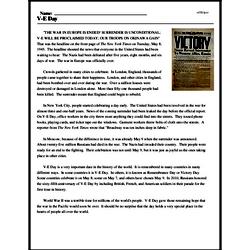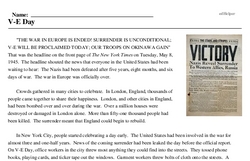V-E Day
"THE WAR IN EUROPE IS ENDED! SURRENDER IS UNCONDITIONAL; V-E WILL BE PROCLAIMED TODAY; OUR TROOPS ON OKINAWA GAIN" That was the headline on the front page of The New York Times on Tuesday, May 8, 1945. The headline shouted the news that everyone in the United States had been waiting to hear: The Nazis had been defeated after five years, eight months, and six days of war. The war in Europe was officially over.
Crowds gathered in many cities to celebrate. In London, England, thousands of people came together to share their happiness. London, and other cities in England, had been bombed over and over during the war. Over a million houses were destroyed or damaged in London alone. More than fifty-one thousand people had been killed. The surrender meant that England could begin to rebuild.
In New York City, people started celebrating a day early. The United States had been involved in the war for almost three and one-half years. News of the coming surrender had been leaked the day before the official report. On V-E Day, office workers in the city threw most anything they could find into the streets. They tossed phone books, playing cards, and ticker tape out the windows. Garment workers threw bolts of cloth onto the streets. A reporter from The New York Times wrote that "Broadway was ten inches deep in fabric."




